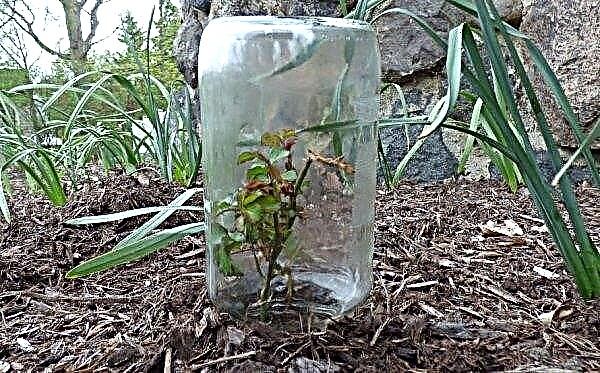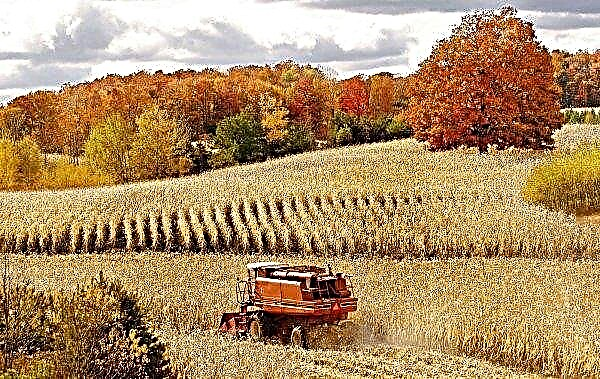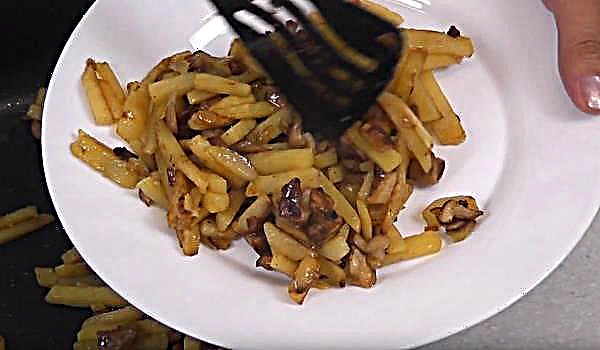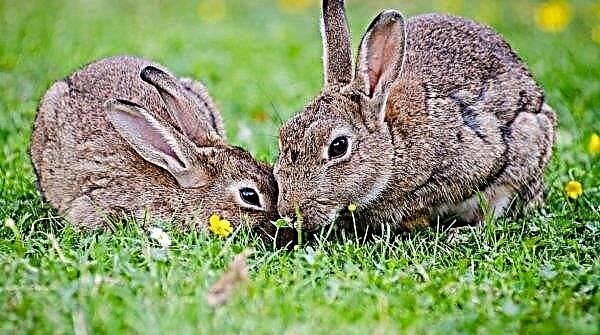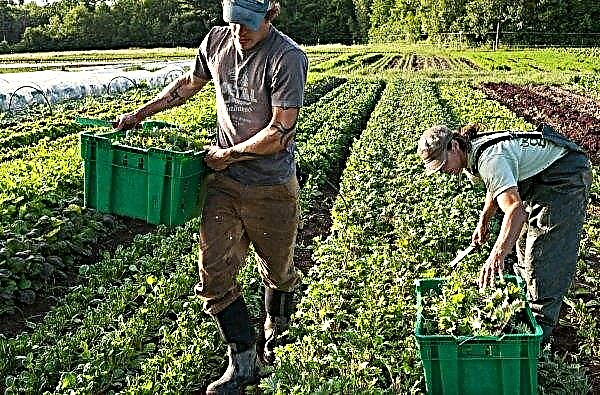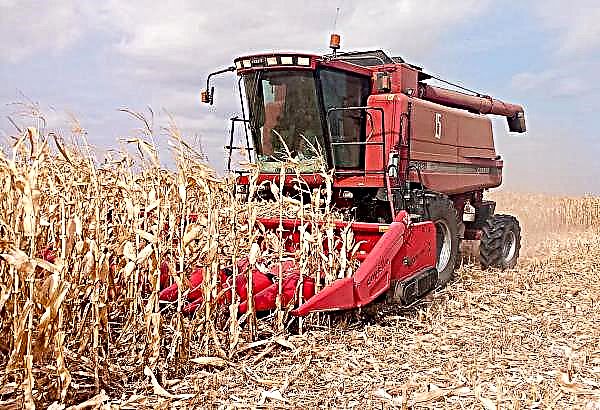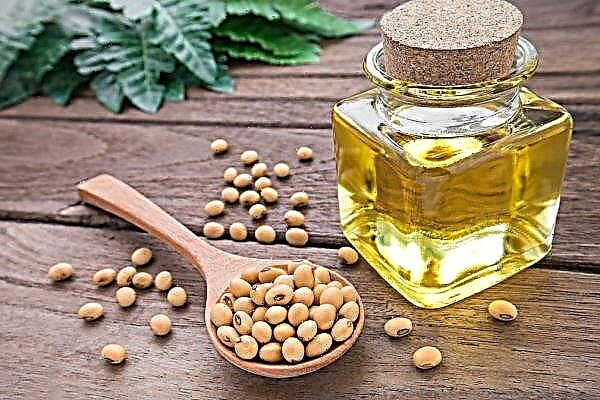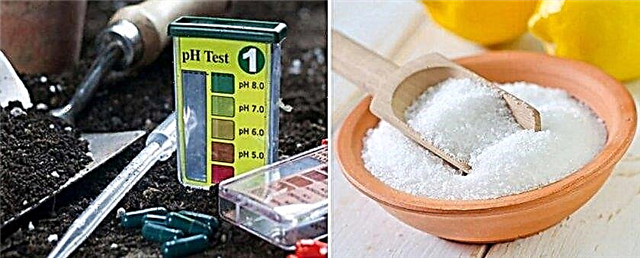Cucumbers are a widespread and popular culture. Demand for this vegetable encourages breeders to develop new, more advanced varieties. The article will introduce you to the Ajax cucumber variety, as well as talk about the methods of growing this plant and the features of caring for it.
General description of the variety
The Ajax F1 cucumber variety is a first-generation hybrid, as evidenced by the F1 symbols in the name, and has the following biological and varietal characteristics:
- stalk in the form of strong and long lashes, branching, lianiform;
- the formed bushes are strong and tall, therefore, they need a garter to the supports;
- type of flowering - female, with a small number of male flowers;
- pollination by insects;
- weak pinching;
- the plant is indeterminate, that is, capable of unlimited growth;
- wrinkled leaves, dark green, medium in size;
- early ripening variety, ripening period from the first seedlings - 32–44 days;
- fruiting under proper conditions - up to 120 days, that is, until October;
- Zelentsy fruits have high pickling and flavoring qualities - they are cylindrical, tuberous, weighing up to 100 g and a length of 9-12 cm. The color is green with a whitish bloom, without signs of bitterness, do not turn yellow, the ratio of length and width is 3: 1;
- the direction of use is fresh, salted and canned.
 Unlike other varieties, Ajax easily tolerates an arid climate and a significant decrease in temperature.
Unlike other varieties, Ajax easily tolerates an arid climate and a significant decrease in temperature.Selection
Ajax F1 cucumber variety was included in the State Register of the Russian Federation of selection plants in 2000. The originator is Nunhems, the Netherlands. The variety is declared as a hybrid of the first generation for cultivation in farmers and private garden farms in open areas.
The most suitable region for landing
The best regions for cultivating Ajax F1 cucumbers are forest-steppes and steppes with a warm and humid climate (temperate and subtropical zone).
Although the variety is recommended by breeders for cultivation in any region, on clay and sandy soils in regions with a dry climate it is possible to ensure marketable yields only by increasing the cost item (irrigation, fertilizers), which is not economically viable.
Ripening time
The variety is declared as ripe, ripening and fruiting occurs after 32–44 days. Zelentsy take off on 7-12 days after flowering and pollination. With proper care and favorable weather conditions, fruiting is possible until mid-autumn, that is, until October.
Ajax F1 is planted with seedlings in pots around May 15–25 (forest-steppe zone, Polesie) or May 5–15 (steppe zone). Based on these dates, it is easy to calculate the timing of maturation. The culture perfectly tolerates temperature fluctuations: it withstands both intense heat and a significant cooling.
The culture perfectly tolerates temperature fluctuations: it withstands both intense heat and a significant cooling.
Productivity
Originators of the variety declare the likely yield (t / ha) for farms:
- use of backwater - 300-350;
- fertile soil - 600–700;
- backwater, fertile soil, drip irrigation - 700-850.
According to gardeners, you can get up to 8 kg of cucumbers from the bush.
Advantages and disadvantages
Like every variety, Ajax has its advantages and disadvantages.
- The advantages of the variety ensures the fulfillment of the set of basic requirements for the cucumber:
- productivity;
- early ripening;
- friendly formation of early Zelentsy;
- fruit strength (use for pickling and canning);
- cultivation in order to obtain gherkins and pickles;
- good germination of seeds;
- drought and cold tolerance;
- resistance to diseases (spotting, mosaic, powdery mildew).
- Disadvantages:
- requires additional care, on which productivity depends;
- seeds must be purchased in specialized stores, since it is impossible to select seed material from hybrids for further cultivation;
- high cost of seeds;
- Ajax needs pollination by bees, so it is best to grow it in open areas;
- tall plant, needs support;
- low fresh taste (according to reviews), which are improved by canning.

Features of planting cucumbers
Planting cucumbers is a rather time-consuming process, which depends on the method of sowing. Cucumbers are sown with seeds in an open area or planted with seedlings.
Did you know? Landgurke cucumber variety bears fruit up to 5–10 kg In everyday life it is called "overgrowth" — it has good taste and hard seeds, like a pumpkin.
Seedling method
The best is the seedling method of growing Ajax F1 in pots. Getting strong seedlings is the key to a future crop.
- The advantages of this method:
- early ripening;
- seed saving;
- early plant protection.
The soil for seedlings is prepared from such mixtures:
- peat and humus (1: 3);
- humus and sod land (3: 1).
 Also for every kilogram of soil add:
Also for every kilogram of soil add:- ammonium nitrate (0.8–1 g);
- superphosphate (1–1.5 g);
- potassium sulfate (0.7–1 g).
Important! The addition of decomposed and weathered peat to the soil mixtures prevents the development of root rot.
It is convenient to use special tablets that already contain the necessary nutrients.
Seeding is carried out based on the calculation of transplanting seedlings at the age of 22–25 days, that is, when 3-4 leaves appear. The embedment depth is 1.5–2 cm.
Seedling containers contain at a temperature of + 27 ... + 28 ° C until germination. Then the temperature can be reduced (+ 20 ... + 24 ° С during the day and + 18 ° С at night). In addition, they carry out the rejection of weak seedlings.
Watering is necessary moderate - when the top layer dries. Excessive moisture can lead to seedling disease and weakening of the root system.
After the appearance of the first sheet for feeding seedlings, you can use the preparations "Vigortem-S", "Orton-seedlings", Effekton. " The introduction of nutrients is desirable to combine with watering at the root and carried out in the form of foliar dressing with microelements - spraying.
The need for fertilizer can be determined by the appearance of the seedlings - these are signs such as slow growth, drop of leaves, elongated and weak stalk.
Planting seedlings in open areas is carried out from May 5 to 15, depending on the climatic characteristics of the region (temperature + 20 ... + 25 ° С) with the exception of possible frosts. The distance between the shoots should be 13-18 cm, depending on the width of the aisle (it is worth planting closer with a wide passage). The row spacing is 50–70 cm for garden plantings and 1–2 m for farmers, using equipment. In any case, the planting rate should be as follows - 2-3 plants per 1 m².
The row spacing is 50–70 cm for garden plantings and 1–2 m for farmers, using equipment. In any case, the planting rate should be as follows - 2-3 plants per 1 m².
After planting, the plants are watered, mulched (2 cm) with sawdust or peat and covered with a film or other non-woven material from a possible cooling.
Important! Cucumber seedlings are planted in an open area by transshipment with a lump of earth or together with a peat pot in order to avoid damage to the roots.
In a reckless way
It is advisable to prepare the soil for sowing seeds directly to the open area, as well as for planting seedlings in the fall, by forming ridges 50–70 cm wide and applying fertilizers, peat and manure.
A plot for crops is selected, taking into account the crop rotation:
- the preferred area is where early and cauliflower, onions, corn, and legumes grew;
- areas after pumpkin crops, tomatoes, and pepper should be avoided.
When choosing a site, it should be remembered that bright and intense lighting accelerates flowering, but leads to early aging of plants and a decrease in yield. Better lighting is diffused light under the crowns of trees, but total shading should be avoided.
The beds before sowing seeds and transplanting seedlings can be covered with a film for better warming.
Purchased seeds are usually processed and prepared for planting. Sowing of seeds is carried out when the air and soil warm up to a temperature of at least + 20 ° C. Seeds are laid in moist soil to a depth of 1-2 cm, slightly crushing.
Sowing of seeds is carried out when the air and soil warm up to a temperature of at least + 20 ° C. Seeds are laid in moist soil to a depth of 1-2 cm, slightly crushing.
After the appearance of the first seedlings, they are thinned out, rejecting weak and damaged ones.
Important! Using fresh manure as a fertilizer gives bitterness to cucumbers and can cause brown spotting.
Cucumber care after planting
Care after planting in a permanent place consists of the following actions: forming a bush, mulching, watering, cultivating, weeding and top dressing.
Bush formation
Ajax variety has a weak formation of stepsons, which is provided by selection for the convenience of the correct formation of a bush in order to extend the fruiting period:
- first 2-3 knots - stepsons are removed;
- knots at a height of 80–100 cm - stepchildren leave and pinch on 2-3 leaves with fruits;
- nodes at a height of more than 1 m - stepchildren grow up to 4-5 sheets.
For maximum results, bee pollinating hybrids should be carried in one vertical stem and in one tier, tied to a net or to trellis. At the initial formation, the sprout is tied to the lower part of the trellis with a soft rope, with further growth, the stem clings to the antennae and fills the rows. They are also fastened with ropes. On powerful bushes, you can not pinch the top, but let the cucumber whip down.
On powerful bushes, you can not pinch the top, but let the cucumber whip down.
It is advisable to complete the formation of the bush by mid-July, removing the shoots and lower leaves.
Important! Mustaches take food from the plant, and clinging to the leaves, twist them. It is recommended not to completely remove the mustache, but simply shorten it, which simplifies the care of cucumbers.
Fertilizing and watering
The root system of Ajax cucumber is compact and poorly absorbent, so special attention should be paid to plant nutrition. In addition, a feature of the plant is that with a rapid increase in green mass, the amount of nutrients in the earth decreases, and cucumbers cannot tolerate high concentrations of these substances.
Therefore, food for cucumbers should be made fractionally and in small portions.
After a fourfold selection of fruits, the plant must be fed with nitrogen (manure, nitrate) to build green mass. And after abundant pinching (after 4-5 days), phosphorus and potassium fertilizers are used to ensure intensive flowering and the formation of ovaries.
Top dressing:
- First - during flowering. 5 g of ammonium nitrate, superphosphate, potassium sulfate per bucket of water.
- Second - the beginning of fruiting. The same components, but the content of the nitrogen component is reduced by 2-3 times.
- Third - a week after the second. 5 g of potassium sulfate and superphosphate, 10 g of urea per bucket of water.
 Foliar top dressing during the growing season is made with a solution of urea (25 g per bucket of water), fertilizer solutions with salts of boron, fluorine, iron and manganese.
Foliar top dressing during the growing season is made with a solution of urea (25 g per bucket of water), fertilizer solutions with salts of boron, fluorine, iron and manganese.It is advisable to introduce nutrients during the next irrigation in dissolved form.
Important! An excess of nitrogen provokes the growth of leaves and shoots to the detriment of the formation of the number of female flowers.
Cucumber is a moisture-loving plant, its fruit consists of 97% water, therefore, in order to collect such an amount of moisture, it needs frequent and plentiful watering.
Irrigation is carried out with warm (heated in the sun) water, since the culture painfully perceives the temperature of the water below the temperature of the soil. Before the formation of the ovaries, the procedure is carried out every 2-3 days, in the fruiting phase - daily, trying not to erode the topsoil.
Water consumption is 8–20 l per 1 m². It is useful to spray plants to saturate the air among the stems with moisture.
With a lack of moisture:
- plants grow poorly and slowly;
- first ovaries fall;
- reduced productivity and quality of greenhouses.
Soil care
Loose, warm, moisture- and breathable soil contributes to the active growth and development of the plant. The soil under the cucumbers is loosened for the first time by 12–15 cm, each time reducing the depth so as not to damage the roots: the second loosening is 8–10 cm, and the next is 5–7 cm. After irrigation, the resulting soil crust is loosened to a depth of 1, 5–2 cm.
The soil under the cucumbers is loosened for the first time by 12–15 cm, each time reducing the depth so as not to damage the roots: the second loosening is 8–10 cm, and the next is 5–7 cm. After irrigation, the resulting soil crust is loosened to a depth of 1, 5–2 cm.
Together with loosening, weeding is also carried out, since weeds take away soil nutrients from the plant, obscure plantings and contribute to the spread of diseases (root and stem rot).
Mulching with a layer of 2-3 cm helps to keep warm in the soil (as cucumbers like), retains moisture, inhibits the growth of weeds. In addition, straw or sawdust will protect the fruit from contact with the ground and decay.
Did you know? If you plant a sunflower or corn near the stalk of a cucumber, then these plants will serve as a support and will eliminate the need to search for stakes for garter.
Pest and Disease Control
Pests of cucumbers are such insects:
- thrips (sucks juice from leaves and stems);
- spider mite;
- field slugs;
- gall nematode;
- caterpillars of scoop gamma.
Pest control is the use of insecticides according to the instructions. Careful monitoring of plants will allow you to notice the signs of diseases in time:
Careful monitoring of plants will allow you to notice the signs of diseases in time:
- small black-brown seals - powdery mildew. Sulfur sprinkling is required (sulfur preparation);
- brown dry spots and black dots on fruits and leaves - fungal diseases. We need systemic fungicides;
- growth retardation, leaf fall, dark root neck - root and stem rot. Systemic fungicides are used.
If it is necessary to process plantings with chemicals, the fruits are maximally harvested before processing. A further selection of cucumbers is carried out in a week.
For the prevention of diseases and pests, it is necessary to observe crop rotation, pickle seeds, destroy plant debris, monitor soil moisture.
Harvesting and storage
When gathering greens, you should pay attention to the readiness of the fruits for harvesting - this is a state of maturity and value:
- 10 cm and more - use fresh;
- 3-4 cm - preparation of pickles and gherkins;
- 8-10 cm —for canning;
- up to 18 cm - for salting.
The best time to gather Zelentsy is in the early morning or evening. It is recommended to separate the fruits from the bush with a knife, scissors or secateurs in order to avoid damage to the lashes, leaving part of the stalk on the bush. A selection of greenery is done every 2-3 days so as not to delay the growth of subsequent ovaries, and daily during ripening. Freshly picked cucumbers should be placed in a cold room or covered with a woven material to protect from wind and sun in order to prevent from wilting.
Freshly picked cucumbers should be placed in a cold room or covered with a woven material to protect from wind and sun in order to prevent from wilting.
Fresh cucumbers the next day lose their taste, so it is advisable to eat or process them as soon as possible.
For short-term storage, a refrigerator, a cellar where the required temperature and humidity are provided (+ 6 ... + 8 ° С, 80–90%) are suitable. In such conditions, cucumbers can be stored for up to three weeks.
Ajax can be harvested from the beginning of summer until mid-autumn.
Did you know? In the applications for Android you can find valuable information for the gardener - useful tips, guides and sowing calendars, according to which you can choose favorable days for sowing and maturity dates of any type of plant.
Caring for a cucumber Ajax F1 requires a lot of attention and labor costs. However, if all the requirements for the cultivation of this variety are met, the reward for the efforts will be a plentiful harvest, which, if sold, will bring substantial income or replenish the storerooms with blanks for the winter.


